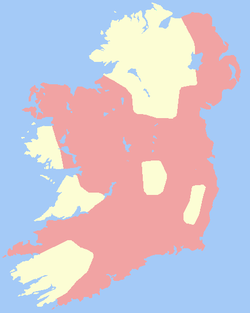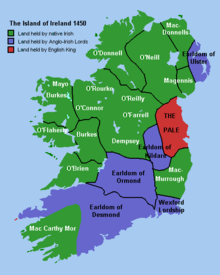- Lordship of Ireland
-
Main article: History of Ireland 1169–1536
Lordship of Ireland
Tiarnas na hÉireann← 
1171–1541  →
→

Banner Coat of arms1 Ireland in 1300 showing the Lordship's maximum extent (pink). Capital Dublin, Carlow (1361–98) Language(s) Irish, English, French, Old Norse Government Monarchy Lord of Ireland - 1171–89 Henry II (first) - 1509–41 Henry VIII (last) Lord Lieutenant - 1316–18 The Lord Mortimer (first) - 1529–34 The Duke of Richmond and Somerset (last) Legislature Parliament of Ireland - Upper house Irish House of Lords - Lower house Irish House of Commons History - Established 1171 - Kingdom of Ireland established 1541 Today part of  Ireland
Ireland
 United Kingdom2
United Kingdom21A commission of Edward IV into the arms of Ireland found these to be the arms of the Lordship. The blazon is Azure, three crowns in pale Or, bordure Argent. Typically, bordered arms represent the younger branch of a family or maternal descent.[1][2]
2Northern Ireland.The Lordship of Ireland (Irish: Tiarnas na hÉireann) refers to that part of Ireland that was under the rule of the king of England, styled Lord of Ireland, between 1177 and 1541. It was created in the wake of the Norman invasion of Ireland in 1169–71 and was succeeded by the Kingdom of Ireland. As the Lord of Ireland was also King of England, he was represented locally by the Lord Lieutenant of Ireland.
Ostensibly, the lordship extended throughout all of Ireland. However, in reality, the kings rule only ever extended to parts of the island. Areas under English rule expanded and retreated over time. Some areas remained separate outside of English rule until the 16th century.
The feudal system allowed a significant amount of practical autonomy for the Hiberno-Norman noble houses who carved earldoms out for themselves and had almost as much authority as some of the native Gaelic kings
Contents
Background
The authority of the Lordship of Ireland's government was seldom extended throughout the island of Ireland at any time during its existence but was restricted to the Pale around Dublin, and some provincial towns, including Cork, Limerick, Waterford, Wexford and their hinterlands. It owed its origins to the decision of a Leinster dynast, Diarmait Mac Murchada (Diarmuid MacMorrough), to bring in a Norman knight based in Wales, Richard de Clare, 2nd Earl of Pembroke (alias 'Strongbow'), to aid him in his battle to regain his throne, after being overthrown by a confederation led by the new Irish High King (the previous incumbent had protected MacMurrough). Henry II of England, who reigned over England and ruled over parts of France, invaded Ireland to control Strongbow, whom he feared was becoming a threat to the stability of his own kingdom on its western fringes (there had been earlier fears that Saxon refugees might use either Ireland or Flanders as a base for a counter-offensive after 1066); ironically, much of the later Plantagenet consolidation of South Wales was in furtherance of holding open routes to Ireland.
Laudabiliter 1155
Another reason King Henry invaded Ireland was because Pope Adrian IV, the only Englishman to have occupied the papal throne, had issued a papal bull Laudabiliter (1155) authorising the English monarch to take possession of Ireland. Religious practices in Ireland and organisation had evolved divergently from those of areas of Europe influenced more directly by the Holy See, although many of these differences had been eliminated or greatly lessened by the time the bull was issued in 1155.[3] Further, the former Irish church had never sent its dues ("tithes") to Rome. Henry's primary motivation for invading Ireland 1171 was to control Strongbow and other Norman lords. In the process he accepted the fealty of the Gaelic kings at Dublin in November 1171, and he summoned the Synod of Cashel in 1172, which brought the Irish Church into conformity with English and European norms.
The pope asserted the right to grant sovereignty over islands to different monarchs on the basis of a document, later proved to be a forgery, called the Donation of Constantine. Doubts were cast by eminent scholars on Laudabiliter itself in the 19th century, but its effect was confirmed by letters of Pope Alexander III and by the facts on the ground. The Papal power to grant also fell within the remit of Dictatus papae (1075–87). While Laudabiliter had referred to the "kingdom" of Ireland, the Papacy was ambiguous about describing it as a kingdom as early as 1185.
John, Lord in 1177–1216
Having captured a small part of Ireland on the east coast, Henry used the land to solve a dispute dividing his family. For he had divided his territories between his sons, with the youngest being nicknamed "Jean sans-terre" (in English, "John Lackland") as he was left without lands to rule. At the Oxford parliament in May 1177, Henry replaced William FitzAldelm and granted John his Irish lands, so becoming Lord of Ireland (Dominus Hiberniae) in 1177 when he was 10 years old, with the territory being known in English as the Lordship of Ireland.
Henry had wanted John to be crowned King of Ireland on his first visit in 1185, but Pope Lucius III specifically refused permission. "Dominus" was the usual title of a king who had not yet been crowned, suggesting that it was Henry's intention. Lucius then died while John was in Ireland, and Henry obtained consent from Pope Urban III and ordered a crown of gold and peacock feathers for John. In late 1185 the crown was ready, but John's visit had by then proved a complete failure, so Henry cancelled the coronation.[4]
Following the deaths of John’s older brothers he became King John of England in 1199, and the Lordship of Ireland, instead of being a separate country governed separately by a junior Norman prince, became another territorial possession of the Norman-English Crown.
Progress and decline
Main article: History of Ireland 1169–1536The Lordship thrived in the 13th century during the Medieval Warm Period, a time of warm climate and better harvests. The feudal system was introduced, and the Parliament of Ireland first sat in 1297. Some counties were created by shiring, while walled towns and castles became a feature of the landscape. But little of this engagement with mainstream European life was of benefit to those the Normans called the "mere Irish". "Mere" derived from the Latin merus, meaning pure.
The Norman élite and churchmen spoke Norman French and Latin. Many poorer settlers spoke English, Welsh and Flemish. The Gaelic areas spoke Irish dialects. The Yola language of County Wexford was a survivor of the early English dialects.
The Lordship suffered invasion from Scotland by Edward Bruce in 1315–18 which destroyed much of the economy and coincided with the great famine of 1315–7. The earldom of Ulster ended in 1333 and the Black Death of 1348–50 impacted more on the town-dwelling Normans than on the remaining Gaelic clans. In 1366 the Statute of Kilkenny tried to keep aspects of Gaelic culture out of the Norman-controlled areas, but in vain. Historians refer to a Gaelic revival or resurgence between 1350 and 1500, by which time the area ruled for the Crown — "the Pale" — had shrunk to a small area around Dublin.
Between 1500 and 1541 a mixed situation arose. Most clans remained loyal to the Lord most of the time, using a Gaelic-style system of alliances centred around the Lord Deputy who was usually the current Earl of Kildare. However a rebellion by the 9th Earl's heir Silken Thomas in 1535 led on to a less sympathetic system of rule by mainly English-born administrators. The rebellion and Henry VIII's seizure of the Irish monasteries around 1540 led on to his plan to create a new kingdom based on the existing parliament.
Lordship to Kingdom, 1541
English monarchs continued to use the title "Lord of Ireland" to refer to their position of conquered lands on the island of Ireland. The title was changed by the Crown of Ireland Act passed by the Irish Parliament in 1541 when, on Henry VIII's demand, he was granted a new title, King of Ireland, with the state renamed the Kingdom of Ireland. Henry VIII changed his title because the Lordship of Ireland had been granted to the Norman monarchy by the Papacy; Henry had been excommunicated by the Catholic Church and worried that his title could be withdrawn by the Holy See. Henry VIII also wanted Ireland to be become a full kingdom to encourage a greater sense of loyalty amongst his Irish subjects, some of whom took part in his policy of surrender and regrant.
Parliaments and great Councils 1318–69
Government was based in Dublin, but the members of parliament could be summonsed to meet anywhere:
- 1310 Kilkenny
- 1320 Dublin
- 1324 Dublin
- 1327 Dublin
- 1328 Kilkenny
- 1329 Dublin
- 1330 Kilkenny
- 1331 Kilkenny
- 1331 Dublin
- 1341 Dublin
- 1346 Kilkenny
- 1350 Kilkenny
- 1351 Kilkenny
- 1351 Dublin
- 1353 Dublin
- 1357 Kilkenny
- 1359 Kilkenny
- 1359 Waterford
- 1360 Kilkenny
- 1366 Kilkenny
- 1369 Dublin
See also
- History of Ireland
- List of Lords of Ireland
- Ireland King of Arms
References
- ^ Perrin, WG; Vaughan, Herbert S (1922), British Flags. Their Early History and their Development at Sea; with an Account of the Origin of the Flag as a National Device, Cambridge, ENG, UK: Cambridge University Press, pp. 51–2.
- ^ Chambers's Encyclopædia: A Dictionary of Universal Knowledge, 1868, p. 627, "The insignia of Ireland have variously been given by early writers. In the reign of Edward IV, a commission appointed to enquire what were the arms of Ireland found them to be "three crowns in pale". It has been supposed that these crowns were abandoned at the Reformation, from an idea that they might denote the feudal sovereignty of the pope, whose vassal the king of England was, as lord of Ireland".
- ^ Poole, Austin Lane (1993), From Domesday book to Magna Carta, 1087–1216, Oxford University Press, p. 303.
- ^ Warren, WL (1960), King John, London, ENG, UK: Eyre & Spottiswoode, p. 35.
- Davies, Norman (1999), The Isles: A History, Palgrave-Macmillan, ISBN 0-333-76370-X.
- Frame, Robin (1982), English Lordship in Ireland 1318–1361, Clarendon Press, ISBN 0-19-822673-X
Preceded by
Gaelic IrelandLordship of Ireland Succeeded by
Kingdom of IrelandIrish states since 1171 Medieval period Gaelic Ireland (until 1607) · Lordship of Ireland (1171–1541)
Modern period Kingdom of Ireland (1541–1801) · United Kingdom of Great Britain and Ireland (1801–1922†)
Twentieth century Irish Free State (1922–37)
Notable declared states Republic of Connaught (1798) · Irish Republic (1919–22) · Munster Republic (1922)
See also Confederate Ireland (1642–53) · Commonwealth of England, Scotland and Ireland (1649–60)
†Date marks the secession of the majority of Ireland from the United Kingdom rather than the creation of a new state. Official name was changed in 1927.Categories:- Former monarchies of Europe
- Former countries in the British Isles
- States and territories established in 1171
- States and territories disestablished in 1541
- History of Ireland
- Former countries in Ireland
- 1171 establishments
- 1541 disestablishments
- History of Ireland by period
Wikimedia Foundation. 2010.


